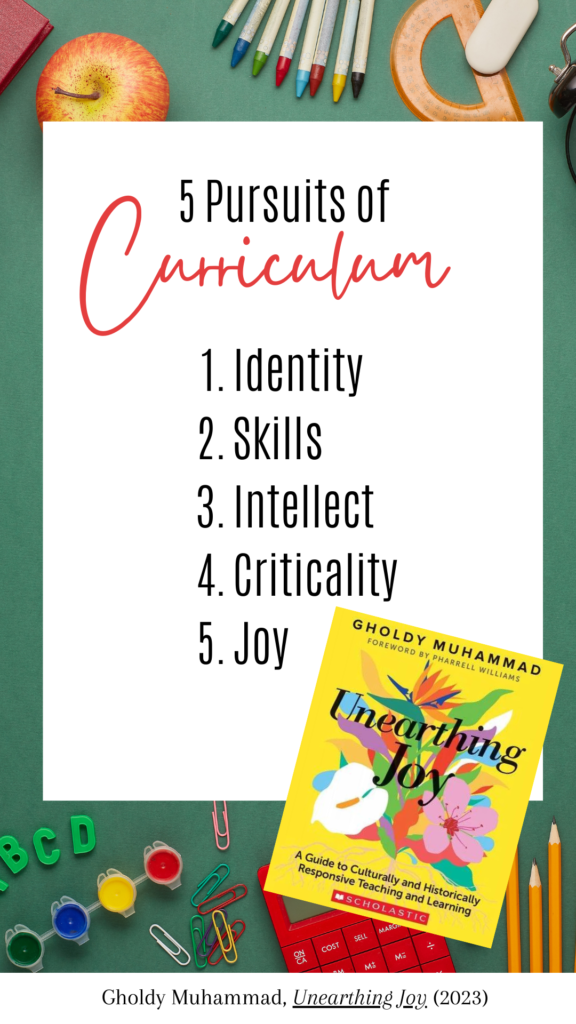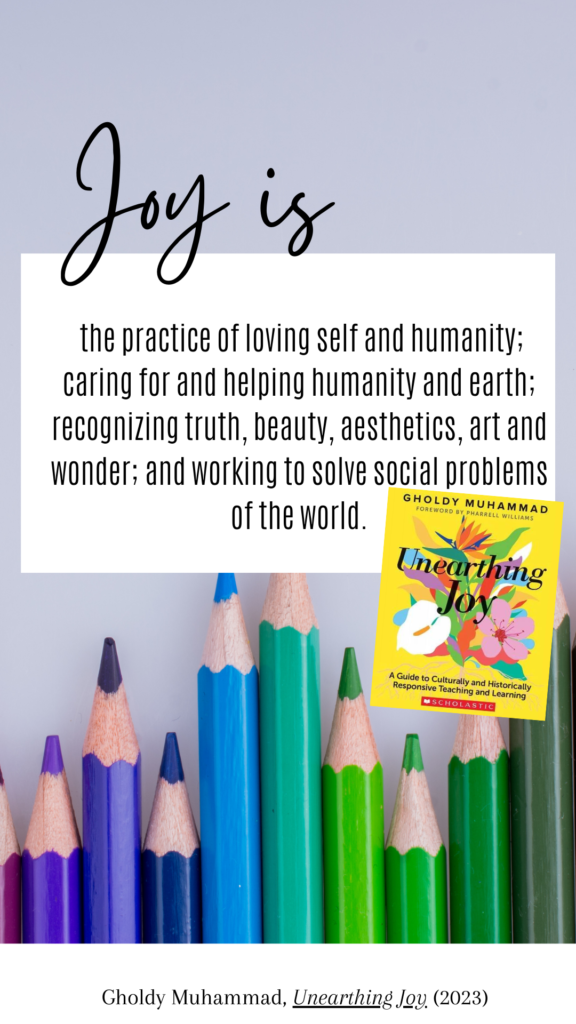Gholdy Muhammad, a scholar, historian, and author, is one of today’s leading voices about Culturally and Historically Responsive Teaching (CHRT). In her most recent 2023 book entitled Unearthing Joy: A Guide to Culturally and Historically Responsive Curriculum and Instruction, Muhammad outlines 5 pursuits of CHRT curriculum: Identity, Skills, Knowledge, Criticality and Joy.

I loved Muhammad’s historically-based, Black-centered model and found myself wanting to see how her 5 pursuits aligned with other curricular frameworks, especially those that I already use within my own classroom. How do they fit together? Are they simply different words for the same or similar concept? Writing this post helped me get my brain sorted out – I hope it resonates with you, too!
What are the 5 pursuits?
In her 2020 book, Cultivating Genius: An Equity Framework for Culturally and Historically Responsive Literacy, Gholdy Muhmmad introduced her first 4 pursuits of curriculum that empower all students: Identity, Skills, Knowledge and Criticality. In her 2023 publication, Unearthing Joy: A Guide to Culturally and Historically Responsive Curriculum and Instruction, she adds Joy as a 5th and final pursuit. But what do each of these pursuits mean?
Identity: Students know who they are.
Muhammad’s first pursuit is identity. It emphasizes the importance of students knowing themselves both personally and in the context of their communities. Identity instruction consists of asking questions like, “Who am I?” “How does my identity my affect relationships and the way I move in the world?” “What does this unit of study teach me about myself?”
Skills: Students have the skills to learn and express their knowledge.
This is the pillar on which most curriculums (over?) focus. Skills incorporate state standards and curricular expectations; they are what the students need to be able to do in order to demonstrate mastery.
Knowledge/Intellectual Knowledge: What students know
Knowledge speaks to students’ content knowledge. It addresses what students know about the world around them: nature, people, technologies, arts and beyond. Going deeper than skills, the pursuit of knowledge in a given unit “refers to the new interdisciplinary and cultural knowledge students acquire to become “smarter” about something.” (Unearthing Joy, pg. 75)
Criticality: How students engage with their learning
The pursuit of criticality asks students to think… critically about their learning. It pushes students to become active in their intake and output of information. In Muhammad’s words, “Criticality pushes students to ask how they can liberate themselves, their, communities, our nation, and our world from discriminatory and oppressive forces.” (Unearthing Joy, pg.76)
Joy: How students find beauty and take action
Muhammad’s final pursuit, Joy, addresses students’ need to find pleasure, happiness, and beauty in their learning. Part of this is seeing learning from multiple modes (art, drama, music) and part is feeling empowered to exact change on the real world around them. Joy calls for students to recognize themselves as active members of the global society.

Aligning with Learning for Justice’s Social Justice Standards
What are the Social Justice Standards?
I’ve been aligning my cross-curricular units of study with Learning for Justice’s Social Justice Standards for about 5 years now. They’re an incredibly helpful tool to incorporate justice in units of study, whether they be ones you’re adapting from a given curriculum or ones that you’re creating yourself.
These standards are organized similarly to the Common Core State Standards in that they have wide overarching categories that address all of K-12, but then are scaffolded in grade bands. The categories are Identity, Diversity, Justice, and Action.

How do the Social Justice Standards align with Muhammad’s 5 pursuits?
- Identity (Identity): Not to be too obvious here, but the LFJ Identity Standards map rather directly onto Muhammad’s Identity pursuit. The K-2 Identity 1 Standard, for example, reads: “I know and like who I am and can talk about my family and myself and name some of my group identities.” This clearly ties to Muhammad’s definition of identity as being “Composed of notions of who we are, who others say we are, and who we desire to be.” (Unearthing Joy, pg. 74)

- Diversity (Knowledge, Criticality): TFJ’s second subgroup of standards lies under the “Diversity” title and connects with two aspects of Muhammad’s framework. Diversity Anchor Standard 8 reads, “Students will respectfully express curiosity about the history and lived experiences of others and will exchange ideas and beliefs in an open-minded way.” This connects with Muhammad’s call for Knowledge – and the pursuit of Knowledge. Diversity Standard 10, however, ties more to the Criticality pursuit. The call for students to “examine diversity in social, cultural, political, and historical contexts rather than in ways that are superficial or oversimplified” connects with Muhammad’s call for students to critically examine the sources of their learning.
- Justice (Knowledge, Criticality): LFJ’s third umbrella category, Justice, connects with the same two pursuits as Diversity, calling for students to seek knowledge and to consume it critically. The anchor standards in this category call for students to recognize how stereotypes, unfairness, and bias are encountered at both individual and systemic levels. This is criticality in action. The Justice standards also call for students to “identify figures, groups, events and a variety of strategies and philosophies relevant to the history of social justice around the world,” necessitating a deep knowledge.
- Action (Criticality, Joy): Learning for Justice’s Actions Standards connect with Muhammad’s pursuits of Criticality, but even more so, Joy. Muhammad says that “joy is the practice of loving self and humanity; caring for and helping humanity on earth; recognizing truth, beauty, aesthetics, art, and wonder; and working to solve social problems of the world.” (Unearthing Joy, p. 77) The LFJ Action standards are all about doing something – taking action – to make the world a more wonderful place. Muhammad names that it is joyful for students to be able to meaningfully respond to their learning in a way that will make real, tangible changes to the world around them.

A note: The only of Muhammad’s pursuits not explicitly connected above is Skills. While no one LFJ standard names specific skills, they ALL call for students to be very skillful. For example, in order to describe how you are the same and different from others, you need to have the skill to talk about yourself, the skills to learn about the other, and then the compare/contrast skills to acknowledge differences.
They’re connected … so what?
As I’ve outlined above, Gholdy Muhammad’s 5 Pursuits of Learning are closely related to Learning For Justice’s Social Justice Standards. So what does that mean for your classroom?
First, it means that you don’t have to reinvent the wheel to make your classroom more Culturally and Historically Responsive. They are experts like Muhammad and the professionals at Learning for Justice who have paved a very thorough, research-backed road for you and your students! They’ve taken out the guesswork and provided a real guide.
Second, it means that you have not only have one, but two resources from which to draw as you seek to transform your classroom. That means that if Muhammad’s definition of Criticality is confusing to you, you can call on the Diversity and Justice LFJ standards to hone in on a specific learning goal for your students.
More from Gholdy Muhammad!
If you, like me, can’t get enough of Muhammad’s guidance for a truly Culturally and Historically Responsive Classroom, check out these other resources!
- Listen to this Interview on Cult of Pedagogy!
- Check out Episode 15 of the To The Classroom podcast hosted by Jennifer Serravallo!


